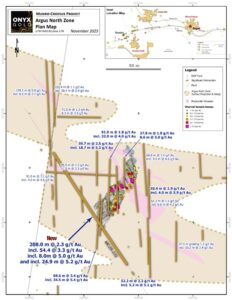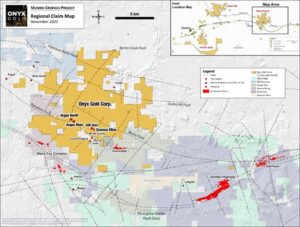
Onyx Gold Expands Argus North Discovery Footprint – 208 m of 2.3 g/t Au, Including 25 m of 5.2 g/t Au
Onyx Gold Corp. (TSX-V: ONYX) (OTCQX: ONXGF) is pleased to report another strong drill intercept from the Argus North Zone as part of the Company’s ongoing drill program at its 100%-owned Munro-Croesus Project, located 75 km east of Timmins, Ontario.
The latest results come from hole MC25-232, which was designed to test a newly defined northeast-trending structural corridor beneath the Argus North outcrop. This target emerged from detailed geological mapping and surface channel sampling that indicated a strong structural control on higher-grade gold distribution (see news release dated October 7, 2025). MC25-232 successfully confirmed this interpretation, delivering the widest continuous interval of gold mineralization encountered at Argus North to date, returning 208.0 meters grading 2.3 grams per tonne gold, while extending the southern footprint of the zone by an additional 50 metres.
Step-out drilling continues to systematically expand the Argus North mineralized system along strike and to depth. Recent holes have returned multiple broad and high-grade intercepts (see news releases dated April 10, June 26, July 23, September 3, October 7, and October 22, 2025), including 69.6 m grading 3.4 g/t Au in the initial discovery hole MC25-232.
New Highlights from Argus North
- 208.0 m grading 2.3 g/t Au, in drill hole MC25-232, including
- 54.4 m grading 3.3 g/t Au, including
- 8.0 m grading 5.0 g/t Au, and
- 4.0 m grading 5.8 g/t Au
- 2.0 m grading 5.5 g/t Au
- 4.0 m grading 4.3 g/t Au
- 24.9 m grading 5.2 g/t Au, including
- 12.0 m grading 7.2 g/t Au, and
- 3.0 m grading 7.5 g/t Au
- 54.4 m grading 3.3 g/t Au, including
- Ongoing step-out drilling at Argus North, combined with mechanical stripping and channel sampling, has continued to demonstrate wide intervals of gold mineralization over >150 meters of strike length and from surface to >350 meters vertically.
- The Argus North Zone remains open along strike, down-dip, and down-plunge.
- The Company has completed 81 drill holes to date (assays announced for 37 holes) completing the previously announced 25,000 m Phase II drill program and announcing a fully-funded 50,000 m Phase III drill program utilizing three drill rigs (See Company news release dated November 13, 2025).
“The 208 metres intersection grading 2.3 g/t gold in MC25-232 represents another significant step forward at Argus North delivering our broadest zone of continuous mineralization to date,” said Brock Colterjohn, President & CEO. “Importantly, these results deliver robust gold continuity close to surface and extends the system 50 meters to the south, further demonstrating the scale and strength of this growing discovery. The consistent mineralization with multiple higher-grade sub-intervals continues to validate our evolving structural interpretation and points to substantial room for expansion. With a fully funded additional 50,000-metre drill program now underway, we are well positioned to accelerate growth at Argus North and to systematically test the broader structural corridor across the Munro-Croesus Project.”
Discussion of 2025 Argus North Drill Results
The Argus North Zone is located on the western half of the Munro-Croesus Project, approximately 150 metres north of the regional Pipestone Fault, a major structural corridor that hosts several significant gold deposits in the Timmins camp. The discovery hole at Argus North, MC24-163, was reported earlier this year, and returned 69.6 m grading 3.4 g/t Au, including 34.5 m grading 5.4 g/t Au and 9.5 m grading 13.9 g/t Au (see Company news release dated April 10, 2025).
Gold mineralization at Argus North is distinguished by both broad zones (50 m to over 100 m) of +1 g/t Au mineralization containing multiple continuous higher-grade sub-intervals. Notable recent high-grade intercepts include 17.0 m grading 5.3 g/t Au in hole MC25-168, 18.7 m grading 5.2 g/t Au in MC25-171, 5.2 m grading 5.1 g/t Au and 6.6 m grading 4.2 g/t Au in MC25-178, 4.0 m grading 6.6 g/t Au in MC25-179, and 4.0 m grading 5.9 g/t Au in MC25-180.
Geologically, the high-grade sub-intervals at Argus North are closely associated with zones of strong albitization and silicification, pyritic stringers, and localized porphyritic intrusions within variolitic basalt and volcanic breccias cut by dominant northeast-trending faults and associated fractures. This combination of alteration and structural preparation is interpreted to be a key control on gold deposition. Drilling to date demonstrates excellent vertical continuity of mineralization, now traced from surface to over 350 meters depth, with the system remaining open along strike, down-dip and down-plunge.
The evolving interpretation of the potential controls on gold mineralization at Argus North stresses the importance of the following key ingredients:
- Proximity to the major regional, deep-seated Pipestone Fault
- Permissive mafic variolitic volcanic stratigraphy
- Zones of notable magnetic destruction and disruption along that key horizon
- Northeast trending structures and structural-geophysical-geochemical corridors
- Feldspar porphyry intrusions acting as fluid barriers and a minor host to gold mineralization; and, most importantly,
- A variety of breccias (hyaloclastic, crackle, jigsaw, and polylithic) which provide permeability for fluid migration and gold accumulation.
Results reported today are for one drill hole, MC25-232, which was drilled to the northwest under the Argus North stripped outcrop after detailed geological mapping and surface channel sampling (included 4.0 m grading 5.0 g/t Au and 7.4 m grading 4.9 g/t Au) revealed a strong northeast-trending structural fabric as a potential control on gold mineralization. Drill hole MC25-232 intersected the broadest zone of gold mineralization at Argus North with significant highlights including:
Table 1 – Significant Assay Results from 2025 Drilling Completed at the Argus North Zone
| Target | From | To | Length | Au |
| Drill Hole | (m) | (m) | (m) | (g/t) |
| Argus North | ||||
| MC25-232 | 59.0 | 63.8 | 4.8 | 3.2 |
| Including | 61.0 | 63.8 | 2.8 | 5.1 |
| Including | 62.0 | 63.0 | 1.0 | 11.0 |
| And | 78.0 | 286.0 | 208.0 | 2.3 |
| Including | 80.0 | 134.4 | 54.4 | 3.3 |
| Including | 89.0 | 90.0 | 1.0 | 8.3 |
| And Including | 104.0 | 112.0 | 8.0 | 5.0 |
| And Including | 128.4 | 132.4 | 4.0 | 5.8 |
| And Including | 187.0 | 189.0 | 2.0 | 5.5 |
| And Including | 201.0 | 205.0 | 4.0 | 4.3 |
| And Including | 218.1 | 243.0 | 24.9 | 5.2 |
| Including | 228.0 | 240.0 | 12.0 | 7.2 |
| Including | 234.0 | 235.0 | 1.0 | 15.2 |
| And Including | 267.8 | 270.8 | 3.0 | 7.5 |
*Intersections are reported as drilled width; true width is unknown.
The intersection in drill hole MC25-232 confirms the mineralization through the heart of the Argus North system, but also extends the known mineralization beyond drill holes MC25-178 and MC25-163 and a further 50 m to the south. The northwest drilling orientation better intersects the northeast-trending structures and has indicated that the mineralized zones extend further south where these structures intersect permissive host lithologies.
The Argus North Zone remains open along strike, down-dip, and down-plunge and the opportunity to expand the zone through ongoing drilling is considered excellent. Details for drill hole assay reported in this news release are shown in Figure 1 and Table 1.
Argus North lies roughly 100 metres north of the east-west trending Argus Main Zone, which represents a separate 750 m x 200 m near-surface bulk-tonnage gold target (e.g., 1.0 g/t Au over 63.3 m and 0.5 g/t Au over 136 m).
Figure 1 – Plan Map Highlighting Argus North Zone Drill Holes Reported in this Release
To view an enhanced version of this graphic, please visit:
https://images.newsfilecorp.com/files/9800/274759_eda78eec3446eb40_001full.jpg
Figure 2 – Location of the Munro-Croesus Gold Project, Ontario
To view an enhanced version of this graphic, please visit:
https://images.newsfilecorp.com/files/9800/274759_eda78eec3446eb40_002full.jpg
The Munro-Croesus Project
The Munro-Croesus Project is located along Highway 101 in the heart of the Abitibi greenstone belt, Canada’s premier gold mining jurisdiction (Figure 2). This large, 100% owned land package includes the past-producing Croesus Gold Mine, which yielded some of the highest-grade gold ever mined in Ontario. Extensive land consolidation from 2020-2025 has unified the patchwork of patented and unpatented mining claims surrounding the Croesus Gold Mine into one coherent package and enhanced the project’s exploration potential.
The Project covers 109 km2 of highly prospective geology within the influence of major gold-bearing structural breaks. Bulk-tonnage gold deposits located in the immediate region include the Fenn-Gib gold project being developed by Mayfair Gold Corp., and the Tower Gold Project being developed by STLLR Gold Inc.
About Onyx Gold
Onyx Gold Corp. is a Canadian exploration company focused on unlocking district-scale gold opportunities in two of the country’s most prolific and proven mining jurisdictions — Timmins, Ontario, and Yukon Territory.
In the Timmins Gold Camp, Onyx controls an extensive portfolio anchored by the Munro-Croesus Property, host to the historic high-grade Croesus Mine and site of the Company’s recent Argus North discovery — one of the most exciting new gold zones emerging in the camp. Complementing Munro-Croesus are two large, early-stage projects — Golden Mile, a 140 km² property situated just 9 km from Newmont’s multi-million-ounce Hoyle Pond Mine, and Timmins South, a 187 km² land package strategically positioned around the Shaw Dome structure, offering exceptional discovery potential.
Beyond Ontario, Onyx holds a commanding land position across four properties in Yukon’s Selwyn Basin, an area rapidly gaining recognition for new gold discoveries and growing exploration investment. The Company’s King Tut Property sits approximately 50km south of Snowline Gold’s Valley discovery and adjacent to Fireweed Metals’s MacPass property.
Led by an experienced team with a strong track record of discovery, development, and value creation, Onyx Gold (TSX-V: ONYX) (OTCQX: ONXGF) is well funded and committed to delivering shareholder value through disciplined exploration, strategic growth, and responsible resource development.
On Behalf of Onyx Gold Corp.
“Brock Colterjohn”
President & CEO
For further information, please visit the Onyx Gold Corp. website at www.onyxgold.com or contact:
Brock Colterjohn, President & CEO
or
Nicole Hoeller, NIKLI Communications – nicole@onyxgold.com
Phone: 1-604-283-3341
Email: information@onyxgold.com
Website: www.onyxgold.com
LinkedIn: https://www.linkedin.com/company/onyx-gold-corp
Twitter: https://twitter.com/OnyxGoldCorp
Additional Notes:
Starting azimuth, dip and final length (Azimuth/-Dip/Length) for the one (1) drill hole reported today are noted as follows: MC25-232 (325/55/366).
Samples of drill core were cut by a diamond blade rock saw, with half of the cut core placed in individual sealed polyurethane bags and half placed back in the original core box for permanent storage. Sample lengths typically vary from a minimum 0.2-meter interval to a maximum 1.5-meter interval, with an average 0.5 to 1.0-meter sample length.
Drill core samples were delivered by truck in sealed woven plastic bags were delivered by truck in sealed woven plastic bags to MSA Labs laboratory facility in Timmins, Ontario for sample preparation followed by the photon assay method. MSA Labs operate meeting all requirements of International Standards ISO/IEC 17025:2017 and ISO 9001:2015. Drill core samples are crushed to 70% passing 2mm, then a representative split is taken and pulverized to 85% passing 75μm. Gold is determined by photon assay of a 500-gram sample providing a true bulk reading. The Chrysos PhotonAssay method utilizes high energy x- rays causing excitation of atomic nuclei allowing enhanced analysis for gold.
Coarse rejects returned from MSA Labs and remaining uncut drill core samples were then delivered by truck in sealed woven plastic bags to ALS Geochemistry laboratory facility in Timmins, Ontario for sample preparation with final analysis at ALS Geochemistry Analytical Lab facility in North Vancouver, BC. ALS Geochemistry operate meeting all requirements of International Standards ISO/IEC 17025:2017 and ISO 9001:2015. Drill core samples are crushed to 70% passing 2mm, then a representative 250 g riffle split is taken and pulverized to 85% passing 75μm. Gold is determined by the fire-assay fusion method of a 50-gram sub-sample with atomic absorption spectroscopy (AAS). Samples that return values >10 ppm gold from fire assay and AAS are determined by using fire assay and a gravimetric finish. Various metals including silver, gold, copper, lead and zinc are analyzed by inductively coupled plasma (ICP) atomic emission spectroscopy, following multi-acid digestion. The elements copper, lead and zinc are determined by ore grade assay for samples that return values >10,000 ppm by ICP analysis. Silver is determined by ore-grade assay for samples that return >100 ppm. All ALS Geochemistry sites operate under a single Global Geochemistry Quality Manual that complies with ISO/IEC 17025:2017. ALS Geochemistry follows the quality management and operational guidelines set out in the international standards ISO/IEC 17025 – “General Requirement for the Competence of Testing and Calibration Laboratories” and ISO 9001 – “Quality Management Systems”.
The Company maintains a robust QA/QC program that includes the collection and analysis of duplicate samples and the insertion of blanks and standards (certified reference material).
Ian Cunningham-Dunlop, P.Eng., Executive Vice President for Onyx Gold Corp. and a qualified person as defined by Canadian National Instrument 43-101, has reviewed and approved the technical information contained in this release.
Neither TSX Venture Exchange nor its Regulation Services Provider (as that term is defined in the policies of the TSX Venture Exchange) accepts responsibility for the adequacy or accuracy of this release.
MORE or "UNCATEGORIZED"
Legacy Gold Intersects Broad Zones of Gold Mineralization at Baner Property, Idaho: Hole 004 - 0.59 g/t Gold Over 71.6 m and 1.15 g/t Gold Over 18.3 m
Legacy Gold Mines Ltd. (TSX-V: LEGY) is pleased to report assay results from six (6) additional Reve... READ MORE
Galiano Gold Advances Towards a Maiden Underground Resource at Abore with Additional High-Grade Results Encountered Including 4.7 g/t Au over 28m and 3.5 g/t Au over 17m
Galiano Gold Inc. (TSX: GAU) (NYSE American: GAU) is pleased to provide an update on the 2025 Abor... READ MORE
First Phosphate Closes Oversubscribed Private Placement to Existing and Follow-on Investors
First Phosphate Corp. (CSE: PHOS) (OTCQX: FRSPF) (FSE: KD0) is pleased to announce that, on November... READ MORE
Revival Gold Intersects 1.4 g/T Oxide Gold Over 44.2 Meters in Shallow Drilling and Extends Mineralization at Mercur
Revival Gold Inc. (TSX-V: RVG) (OTCQX: RVLGF) is pleased to provide further results from ongoing dr... READ MORE
Western Exploration Drilling Confirms New Precious Metals Bearing Epithermal System at Aura Project with 3.0 Meters of 7.1 G/t Gold at Tomasina Fault Zone
Western Exploration Inc. (TSX-V: WEX) (OTCQX: WEXPF) is pleased to announce results of the first fiv... READ MORE















